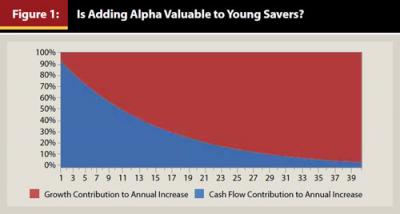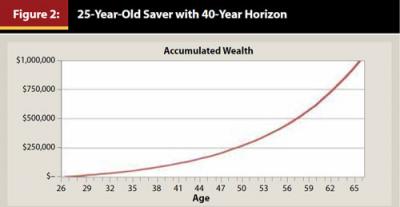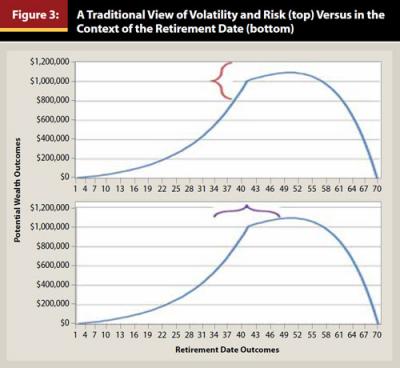Journal of Financial Planning: December 2013
Saving for retirement starting at a young age and taking advantage of the wonder of compounding interest is a long-standing staple of financial planning advice. The longer the time horizon, the less that needs to be saved to achieve a retirement goal. But here’s the caveat: although it’s crucial to start saving initially, after the first decade or two the ongoing contributions have less and less impact, as the results are increasingly dominated—for better or worse—by the portfolio returns.
In fact, by the time the retirement date approaches, the outcome becomes so dependent upon returns that a poor final decade of performance can drastically derail the entire retirement plan. Saving steadily to grow a portfolio over the span of 40 years begins to look more like saving half the goal in the first 30 years, and then trying to quickly double the account balance in the last decade and retire. When viewed from this perspective, it becomes clear that the save-a-little-for-a-long-time approach to retirement is far riskier than most realize.
Ultimately, that doesn’t mean people shouldn’t start saving early for retirement. But it does recognize that a retirement plan that is heavily reliant on compounding returns can have highly adverse outcomes, where the risk is not just the potential that wealth is significantly less than originally projected, but that retirement will have to be significantly delayed.
Accordingly, perhaps it’s time to talk less about risk as standard deviations and the volatility of wealth, and more about retirement date risk and the volatility of when the client will be able to retire.
Saving Young and Starting Early
The mathematical benefits of saving early in life are pretty straightforward—to have $1 million at retirement (assuming an 8 percent growth rate), it takes about $300/month of savings with a 40-year horizon, but it’s almost $700/month with a 30-year horizon, nearly $1,050/month with 25 years, and about $1,700/month with 20 years. As the time horizon shortens, the savings requirement balloons even further; thus the traditional advice of “start saving young.”
However, as the account balance rises—due to the accumulation of ongoing contributions and the annual compounding of growth itself—each additional contribution actually has less and less of an impact on the annual increases of the balance over time. As shown in Figure 1, although in the early years the results are dominated by contributions (growth doesn’t amount to much when there’s hardly any money in the account in the first place) by the later years, returns are the driver for almost all of the increases in the account balance. Shortfalls toward the end simply cannot be made up with new contributions alone.

The results of Figure 1 have significant implications for young investors and the value that advisers can bring to them. Because the impact of returns is very limited in the early years, adding alpha, or just setting up a good asset allocation for proper exposure to beta, has limited value to young savers. How you save and invest matters far less than the mere fact that you save in the early years.
Making good investment allocation decisions doesn’t have much material impact until someone has been compounding savings, or at least accumulating contributions, for a decade or more. On the other hand, while cash flows alone dominate early on, they contribute to less than half the increase in the account balance by year 10, and a fairly trivial amount overall for the entire second half of the savings time horizon.
Relying On Short-Term Returns for Long-Term Success
The problem with a strategy that becomes increasingly reliant on returns over time is that it leaves the prospective retiree highly prone to disappointment if market returns do not add up as anticipated in the final years.
Another way to look at the situation for the saver at age 25 with a 40-year horizon is to recognize that it is so reliant on compounding that the goal to save $1 million by age 65 is really more like a goal to save almost $500,000 by age 55, and then “just quickly double it and retire” a decade later (the contribution from cash flow savings is almost negligible at that point). As Figure 2 shows, the 25 year old who accumulates $1 million by age 65 with regular savings and compounded investment returns is just barely crossing the $500,000 line around age 55.

Of course, few planners would suggest that it’s a good idea to count on market returns to double your account balance in any particular decade; nonetheless, that’s the outcome necessitated by the approach. As Figure 2 reveals, accumulating long-term wealth with steady savings is remarkably reliant not just on getting the projected long-term return for 40 years, but also on getting the necessary return to double in the last 10 years when it matters the most.
Sequencing Risk to Accumulating for Retirement
What the numbers reveal is that just as there’s a significant sequencing risk to retirement (such that we need to take a safe withdrawal rate well below the anticipated growth rate to protect against poor timing of bad returns), there also is a significant sequencing risk to accumulating for retirement. However, for accumulators, the risky sequence is when the bad returns occur at the end (whereas for retirees, the risky sequence is bad returns at the beginning).
Ultimately, this means that planning for a 25 year old to save a small amount for the long-term today, with a plan of retiring at age 65, amounts to making a gargantuan bet that market returns will be favorable from 2043 to 2053 (as the retiree progresses from age 55 to the target retirement age of 65). This is a rather bold prediction for a 10-year horizon that won’t begin for three decades. Of course, that’s also indirectly the bet that a baby boomer born in 1946 was making about the last 10 years before retirement (2001 to 2011). In that scenario, the crucial 10-year horizon at the end of the accumulation years did not turn out as hoped, an unfortunate case-in-point example of this issue.
Market Volatility, Account Balances, and Retirement Date Risk
Given the mathematics of the situation, not only are the outcomes of an accumulation plan increasingly driven by returns in the later years, but plans with longer time horizons are even more impacted by adverse investment results, because they’re more reliant on compounding investment returns.
If returns turn out to be 6 percent instead of 8 percent, saving about $300/month over 40 years winds up to be $586,000 instead of the $1 million originally projected. On the other hand, for the 20-year horizon with $1,700/month of savings, the lower return scenario is still at $789,000. Although the savings is higher with fewer years, the sensitivity of the retirement account balance to returns is lower because of it. The same is true if the longer-term retiree simply chooses to save more and invests more conservatively.
Viewed another way, a shorter (or more conservative return) path may require greater savings, but it also has less risk about whether the target retirement date will be achieved. In the previous scenario where the return is a little low, the individual under the 20-year plan has to keep what he or she was already doing for only three more years to get back to the original $1 million goal (from the $789,000 shortfall). In contrast, the 40-year plan is delayed by more than eight years (to recover from $586,000 back to $1 million). To put it into a real context: the shorter-term and less return-centric saver aiming to retire at 65 is only delayed until age 68 with weaker investment results, while the longer-term saver is actually delayed past age 73 with the same adverse outcome. The risk of a materially delayed retirement is drastically higher with the long-term, low-savings-with-compounding approach.
This perspective arguably presents an alternative and better way of viewing the risk of unfavorable market returns, where clients consider the scenarios based not on the volatility of the wealth outcome, but also on the uncertainty of the retirement date.
In Figure 3, the graph on the top shows a traditional view of volatility and risk, with a range of how high the account balance will rise after 40 years (before it gets spent through retirement). The graph on the bottom shows volatility and risk in the context of the retirement date. The greater the dependency on returns—and their associated uncertainty—the wider the range of potential wealth outcomes (the vertical axis), and the wider the range of retirement date outcomes (the horizontal axis).

Ultimately, the range of retirement dates and the potential length of delay may be a more relevant (and perhaps more motivating) factor for clients. “Your plan has a 20 percent chance of not having $1 million,” is hard for clients to internalize, but “Your plan has a 20 percent chance of delaying your retirement by six years,” is a much more tangible risk/reward trade-off to consider.
The takeaway here is to recognize that the more reliant the plan becomes on returns—whether due to using high-risk, high-return investments, or low savings built on an extremely long time horizon—the greater the risk to the retirement date itself, and the greater the likelihood that the outcome could be materially different than originally planned.
Following a plan with a high reliance on key returns in a small number of years leading up to retirement leads to a concentrated exposure to risk. In some cases, prospective retirees may still wish to take such risks, but perhaps it’s time to acknowledge the ramifications of such risks not in standard deviations of returns and wealth, but in real-world outcomes of potential retirement delays and retirement date risk.
Michael E. Kitces, CFP®, CLU®, ChFC®, RHU, REBC, is a partner and the director of research for Pinnacle Advisory Group. He is publisher of the e-newsletter The Kitces Report and the financial planning industry blog Nerd’s Eye View through Kitces.com, and serves as practitioner editor of the Journal. Follow him on Twitter @MichaelKitces.